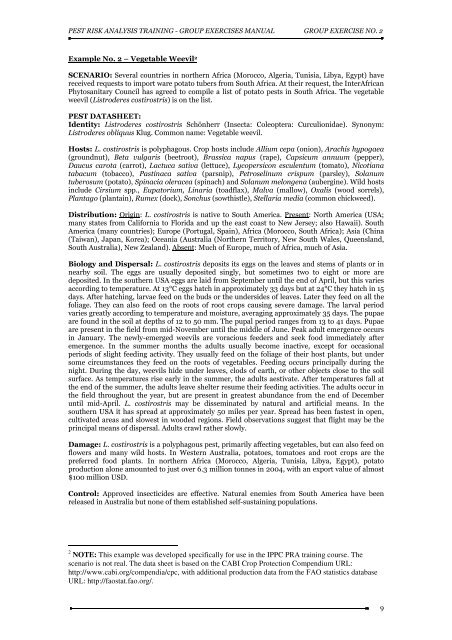PEST RISK ANALYSIS (PRA) TRAINING Group Exercises Manual
PEST RISK ANALYSIS (PRA) TRAINING Group Exercises Manual
PEST RISK ANALYSIS (PRA) TRAINING Group Exercises Manual
Create successful ePaper yourself
Turn your PDF publications into a flip-book with our unique Google optimized e-Paper software.
<strong>PEST</strong> <strong>RISK</strong> <strong>ANALYSIS</strong> <strong>TRAINING</strong> - GROUP EXERCISES MANUAL GROUP EXERCISE NO. 2<br />
Example No. 2 – Vegetable Weevil 2<br />
SCENARIO: Several countries in northern Africa (Morocco, Algeria, Tunisia, Libya, Egypt) have<br />
received requests to import ware potato tubers from South Africa. At their request, the InterAfrican<br />
Phytosanitary Council has agreed to compile a list of potato pests in South Africa. The vegetable<br />
weevil (Listroderes costirostris) is on the list.<br />
<strong>PEST</strong> DATASHEET:<br />
Identity: Listroderes costirostris Schönherr (Insecta: Coleoptera: Curculionidae). Synonym:<br />
Listroderes obliquus Klug. Common name: Vegetable weevil.<br />
Hosts: L. costirostris is polyphagous. Crop hosts include Allium cepa (onion), Arachis hypogaea<br />
(groundnut), Beta vulgaris (beetroot), Brassica napus (rape), Capsicum annuum (pepper),<br />
Daucus carota (carrot), Lactuca sativa (lettuce), Lycopersicon esculentum (tomato), Nicotiana<br />
tabacum (tobacco), Pastinaca sativa (parsnip), Petroselinum crispum (parsley), Solanum<br />
tuberosum (potato), Spinacia oleracea (spinach) and Solanum melongena (aubergine). Wild hosts<br />
include Cirsium spp., Eupatorium, Linaria (toadflax), Malva (mallow), Oxalis (wood sorrels),<br />
Plantago (plantain), Rumex (dock), Sonchus (sowthistle), Stellaria media (common chickweed).<br />
Distribution: Origin: L. costirostris is native to South America. Present: North America (USA;<br />
many states from California to Florida and up the east coast to New Jersey; also Hawaii). South<br />
America (many countries); Europe (Portugal, Spain), Africa (Morocco, South Africa); Asia (China<br />
(Taiwan), Japan, Korea); Oceania (Australia (Northern Territory, New South Wales, Queensland,<br />
South Australia), New Zealand). Absent: Much of Europe, much of Africa, much of Asia.<br />
Biology and Dispersal: L. costirostris deposits its eggs on the leaves and stems of plants or in<br />
nearby soil. The eggs are usually deposited singly, but sometimes two to eight or more are<br />
deposited. In the southern USA eggs are laid from September until the end of April, but this varies<br />
according to temperature. At 13°C eggs hatch in approximately 33 days but at 24°C they hatch in 15<br />
days. After hatching, larvae feed on the buds or the undersides of leaves. Later they feed on all the<br />
foliage. They can also feed on the roots of root crops causing severe damage. The larval period<br />
varies greatly according to temperature and moisture, averaging approximately 35 days. The pupae<br />
are found in the soil at depths of 12 to 50 mm. The pupal period ranges from 13 to 41 days. Pupae<br />
are present in the field from mid-November until the middle of June. Peak adult emergence occurs<br />
in January. The newly-emerged weevils are voracious feeders and seek food immediately after<br />
emergence. In the summer months the adults usually become inactive, except for occasional<br />
periods of slight feeding activity. They usually feed on the foliage of their host plants, but under<br />
some circumstances they feed on the roots of vegetables. Feeding occurs principally during the<br />
night. During the day, weevils hide under leaves, clods of earth, or other objects close to the soil<br />
surface. As temperatures rise early in the summer, the adults aestivate. After temperatures fall at<br />
the end of the summer, the adults leave shelter resume their feeding activities. The adults occur in<br />
the field throughout the year, but are present in greatest abundance from the end of December<br />
until mid-April. L. costirostris may be disseminated by natural and artificial means. In the<br />
southern USA it has spread at approximately 50 miles per year. Spread has been fastest in open,<br />
cultivated areas and slowest in wooded regions. Field observations suggest that flight may be the<br />
principal means of dispersal. Adults crawl rather slowly.<br />
Damage: L. costirostris is a polyphagous pest, primarily affecting vegetables, but can also feed on<br />
flowers and many wild hosts. In Western Australia, potatoes, tomatoes and root crops are the<br />
preferred food plants. In northern Africa (Morocco, Algeria, Tunisia, Libya, Egypt), potato<br />
production alone amounted to just over 6.3 million tonnes in 2004, with an export value of almost<br />
$100 million USD.<br />
Control: Approved insecticides are effective. Natural enemies from South America have been<br />
released in Australia but none of them established self-sustaining populations.<br />
2 NOTE: This example was developed specifically for use in the IPPC <strong>PRA</strong> training course. The<br />
scenario is not real. The data sheet is based on the CABI Crop Protection Compendium URL:<br />
http://www.cabi.org/compendia/cpc, with additional production data from the FAO statistics database<br />
URL: http://faostat.fao.org/.<br />
9













